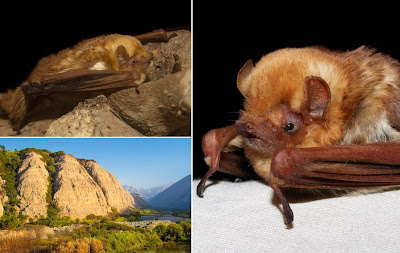 |
Kerivoula pellucida Waterhouse 1854
Kerivoula whiteheadi Thomas, 1894
in Sedlock, Heaney, Balete & Ruedi, 2020.
|
Abstract
Bats of the genus Kerivoula (Mammalia, Chiroptera) are widespread in the Philippines with four reported species, but have been poorly known due to a paucity of specimens. We provide the first molecular phylogeny for Philippine Kerivoula, which supports the existence of four distinct clades that we treat as species (K. hardwickii, K. papillosa, K. pellucida, and K. whiteheadi); these four overlap broadly geographically. Each of these may be recognized on the basis of cytochrome b sequences and external and craniodental morphology. Detailed examination of K. pellucida shows little geographic differentiation within the Philippines, but they differ subtly from those on the Sunda Shelf. We consider K. whiteheadi to be composed of four recognizable clades, each restricted to a geographic region within the Philippines. We consider K. bicolor, from peninsular Thailand, and K. pusilla, from Borneo, to be distinct from K. whiteheadi. Our data indicate the presence of two species within the Philippines currently lumped as K. hardwickii; further study of these is needed. A calibrated phylogeny suggests that Kerivoula began arriving in the Philippines about 10 MYA, with each of the four current lineages arriving independently.
Keywords: Mammalia, biogeography, cytochrome b, echolocation, ecology, morphology, phylogeny, Southeast Asia
 |
FIGURE 5. Photograph composite of Kerivoula pellucida showing the nearly translucent wing membranes (A), pelage color, and ears with tapered tragus (B), membrane attachment on foot and membrane with male gland (C).
A: Bohol I. (no voucher); B–C: FMNH 205817, Cebu I.
FIGURE 12. Photo composite of Kerivoula whiteheadi venter with membrane attachment to foot and bicolor pelage (A), dorsum with fur-lined legs and feet (B), head with pointed tragus and high forehead (C).
A and C: FMNH 205818, Cebu I.; B: FMNH 191330, Luzon I.
|
Kerivoula pellucida Waterhouse 1854
Distribution. Borneo, Java, the Malay Peninsula, the Philippines (Cebu, Jolo, Mindanao, Mindoro, and Palawan), and Siberut (Fig. 2; see also Corbet & Hill 1992: 154).
Kerivoula whiteheadi Thomas, 1894
Distribution. Endemic to the Philippines (Bohol, Camguin Norte, Cebu, Lubang, Luzon, Mindanao, Mindoro, Palawan, Sicogon, Siquijor and Tumaguin; Fig. 2). The type locality “Molino” probably refers to a currently nonexistent village on the east bank of the Ilagan River downstream from the city of San Mariano (M. van Weerd, pers. com., 6 May 2019).
Jodi L. Sedlock, Lawrence R. Heaney, Danilo S. Balete and Manuel Ruedi. 2020. Philippine Bats of the Genus
Kerivoula (Chiroptera: Vespertilionidae): Overview and Assessment of Variation in
K. pellucida and
K. whiteheadi.
Zootaxa. 4755(3); 454–490. DOI:
10.11646/zootaxa.4755.3.2


















































